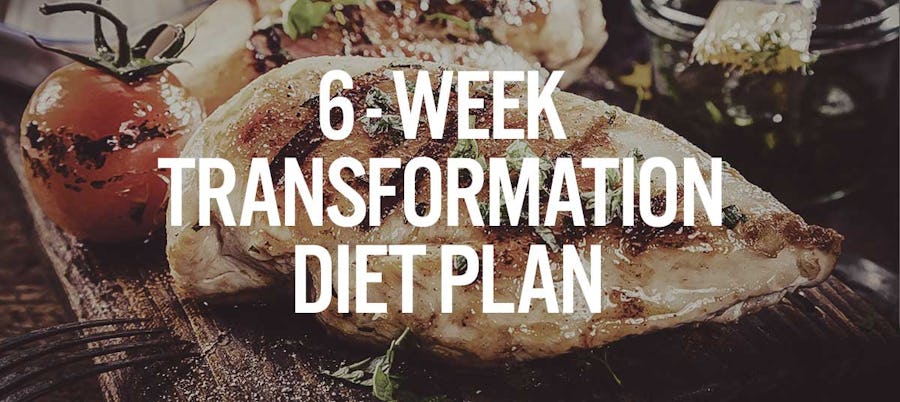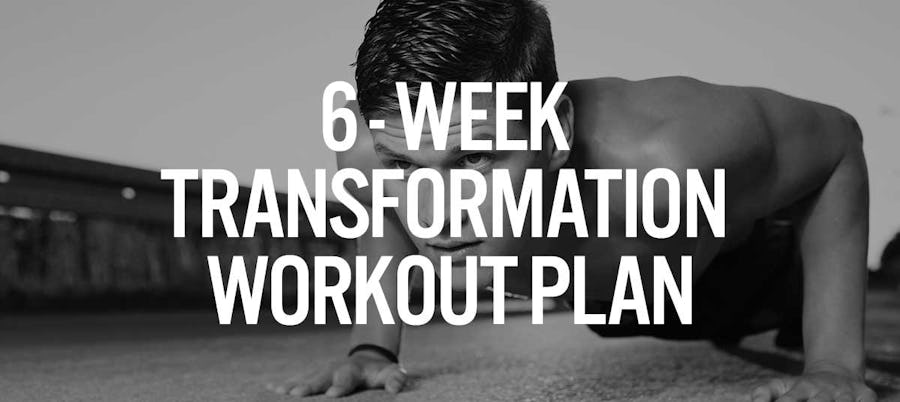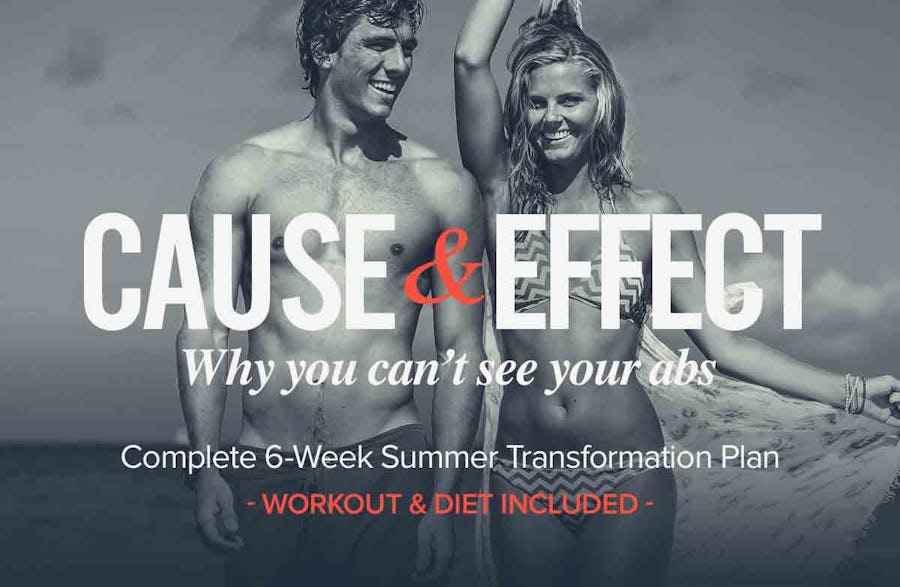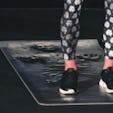Summer is quickly approaching.
You’re ready to expose that ripped body you’ve been working tirelessly in the gym to achieve since January 1. And by now, meal prepping every week has become second nature. The beach is calling your name, and you can’t wait to reveal the sixpack hiding under your shirt.
Sound familiar? No? That’s because it’s likely that none of this is true. Somehow swimsuit season creeps up on us every year. Suddenly, you’re invited on the boat for Memorial Day, and you jump on some extreme calorie-restricted diet for one week hoping that it will magically shed those extra 20 pounds you’ve been carrying around.
Bad news: That’s not going to work.
But it’s OK. It’s almost Memorial Day. And the official start of summer is right around the corner.
If you didn’t get the hint…This is it. Time to get serious. Even if you’re killing it in the gym, you will never see a defined midsection until you get your diet in check. It’s a hassle. You don’t have time to plan…or cook…or think about it. Period.
Good news: We removed the guesswork for you.
Here are 5 reasons why you probably can’t see your abs, and here’s exactly what you’re going to do about it.

Authored By: Jon Celis
Abs are Made in the Kitchen
Abs are totally made in the kitchen! After studying nutrition for four years, I decided to earn a Master’s degree in Holistic Nutrition. With each course that I took, it only further acknowledged that diet is truly the ultimate way to burn fat.
I have learned many fascinating things about diet and how certain foods impact the body, but there’s one key fact I want to point out: Everyone’s biochemistry is different, but nutrition, hormones and physiology will always tell the tale. Essentially you are not just what you eat, you are also what you metabolize.
There isn’t ONE healthy full-proof diet that everyone should eat; however, there are universal dietary principles everyone needs to follow if they want to lose fat and get sixpack abs. Your training can definitely assist in fat loss, but if you are eating Cheetos and drinking beer, don’t expect to look shredded and have any sort of abdominal definition
So what are these universal dietary principles? They are chemical and physiological responses to the type of foods that we eat. Think of the “cause and effect” model, whatever you eat (cause) will result in a specific response (effect).
Here are 5 Physiological Responses:
1.) Carbohydrates and sugar raise your blood sugar.
2.) Excess carbs and sugar that aren’t used for immediate energy (or converted to glycogen) are stored as FAT.
3.) High fructose corn syrup has shown to increase triglycerides (circulating blood fats) causing weight gain and increased FAT.
4.) Insulin is a lipogenic hormone, so it causes you to store FAT.
5.) Protein and dietary fat have no significant impact on raising blood sugar.
*For the record, there are biochemical individualities to consider but nonetheless, these 5 responses are true for everyone.
1. Carbohydrates and Sugar Raise Your Blood Sugar
It’s a fact that carbohydrates raise your blood sugar. These foods include: starches, grains, non-starches, legumes, fruit, refined food and sugars. Excess protein has minimal effect on blood sugar levels as long as adequate insulin is present.
Some of these foods are obviously more aggressive than others, but to put it simply, if you are not seeing your abs, then there is a pretty good chance you are eating a diet that’s raising your blood sugar.
Look at your midsection, then look at your diet. You will see just how well or not you are controlling your blood sugar.
2. Unused Carbs and Sugar are Immediately Stored as FAT
Your body metabolizes carbohydrates and sugar in it’s most simple form, glucose. In short, glucose is stored in two places (1) your liver and (2) your muscles. The storage form of glucose is called glycogen. Unfortunately you only have limited storage space, so any excess metabolized sugar will have nowhere to go. But it’s got to go somewhere, so it gets converted to fat.
This happens because high levels of free glucose in the blood are toxic so your body is actually trying to help you by storing it as fat. However, unlike glycogen, your body will continue to store fat and eventually, it’ll turn into love handles and muffin tops.
3. High fructose corn syrup has shown to increase triglycerides causing weight gain and increased FAT.
It is true that your body can metabolize and handle low doses of HFCS. This however, is only true with high level athletes and not the average mom, dad, or weekend warrior. Elite athletes are at another level in terms of fuel utilization and metabolism. It has been shown that athletes can tolerate some HFCS and, in turn, utilize it as energy, but exercise physiologists can’t really agree on the exact dosage for athletes to use.
However, HFCS has NO nutritional value for your body, so why consume it? HFCS is a manmade toxic substrate that will only get metabolized by the liver as fat. This newly converted fat can fatten up your liver or be stored subcutaneously as body fat. It is found in many processed foods, sport drinks, juices, and energy bars. Avoid it at all costs.
4. Insulin is a Lipogenic Hormone
Insulin is the hormone responsible for stabilizing blood sugar. When you eat any type of carb, insulin is secreted via the pancreas. Insulin’s role is to remove glucose from your bloodstream. Basically, insulin binds to your cell membrane, activates “glucose transporters” within that cell, ultimately allowing glucose to come into the cell.
The more carbs you eat, the more you start to desensitize your cells and your cells get worse at hearing insulin’s signals. When this happens, glucose stays in your bloodstream longer and has nowhere to go. Excess glucose is converted into fat.
Bottom line: Don’t over-stress insulin secretion. Your cells’ receptors like to work part time, and you will piss them off if you start trying to make them work overtime. I recommend eating non-starchy vegetables as your main source of carb consumption because they have the least impact on stimulating insulin.
5. Protein and Dietary Fat Has No Significant Impact on Blood Sugar
In terms of blood sugar, both protein and fat have an insignificant relationship with raising blood sugar. Carbohydrates and sugar are the MAIN culprits. Protein will convert into glucose, but ONLY when it is consumed in the absence of glucose in the diet.

6-Week Transformation Diet Plan
Diet Plan Authored By: Liv Langdon
The truth is, there is more than one diet approach to achieving your ultimate lean self. Every body is unique and responds differently to ‘successful’ diets. The two most important factors in determining which one will work best for you are sustainability and consistency.
The macronutrients are laid out for you once you plug in your individual factors here. You have options. Use those daily macronutrient numbers as goals for the day and use a food tracker like MyFitnessPal to plug in what you eat each day.
The end result is to simply hit those numbers on a daily basis. This allows for more flexibility. We know this is a hassle, so we laid out a detailed nutrition plan below based on your daily caloric intake.
Do: follow the guidelines, eat nutrient-dense food, utilize the substitution guides and vary your food, eat when you’re hungry and drink water.
Don’t: eat processed foods, get obsessed with numbers, over think the number of meals per day, nor be too concerned with nutrient timing.
Give yourself six weeks of maximum effort, and watch your body transform.
1,600-1,800 Calorie Meal Plan
Meal 1: 40g protein | 25g carbohydrates | 15g fat
● Protein: 5 egg whites, 1 whole egg
● Fat: from yolk, 1 tbsp almond butter
● Carbohydrate: ½ cup oatmeal (optional: ¼ cup unsweetened almond milk)
Meal 2: 35g protein | 28g carbohydrates | 20g fat
● Protein: 4-5 oz lean protein
● Fat: ½ avocado (if salmon or lean beef, no avocado)
● Carbohydrate: 4 oz sweet potato, 6-10 spears asparagus
Meal 3: 35g protein | 5g carbohydrates | 25g fat
● Protein: 4-ounce any lean protein
● Fat: 1 tbsp olive oil, balsamic, 1 tbsp crushed walnuts
● Carbohydrate: mixed greens, added veggies
Flex Meal: 35g protein | 34g carbohydrates | 11g fat
(post-workout shake; rearrange to fit your workout schedule)
● Protein: whey protein isolate shake
● Fat: 1 tbsp chia, mix with 1c unsweetened non-dairy milk
● Carbohydrate: 1 cup berries, ¼ cup oats
Total Daily Macros: 145g protein | 95g carbs | 72g fat
2,000-2,200 Calorie Meal Plan
Meal 1: 42g protein | 32g carbohydrates | 25g fat
● Protein: 6 egg whites, 2 whole eggs
● Fat: from yolk, 1 tbsp. peanut butter
● Carbohydrate: ¾ cup (dry measurement) oatmeal, ½ cup berries
Meal 2: 50g protein | 38g carbohydrates | 17g fat
● Protein: 7-ounce lean protein source
● Fat: 1 tbsp. extra virgin olive oil, 1 slice of uncured, nitrate-free bacon
● Carbohydrate: 6-ounce sweet potato, ½ – 1 cup vegetables
Meal 3: 61g protein | 36g carbohydrates | 30g fat
● Protein: 7-ounce fat protein source
● Fat: naturally in the protein sources; if a lean protein source, make sure to add ½ avocado OR approx. 15-18g fat from the fat substitutes in the table below (i.e. handful of nuts, 2 tbsp. olive oil or grass-fed butter)
● Carbohydrate: 1 cup quinoa, 1 cup vegetables
Flex Meal: 37g protein | 41g carbohydrates | 14g fat
(post-workout shake; rearrange to fit your workout schedule)
● Protein: whey isolate protein powder (equivalent to 35g protein)
● Fat: 2 tbsp. all-natural nut butter, 1 tbsp. chia seed, 1 cup unsweetened almond milk
● Carbohydrate: ½ cup berries, ½ banana, ½ cup spinach
Total Daily Macros: 190g protein | 147g carbs | 86g fat
2,500 Calorie Meal Plan
Meal 1: 55g protein | 50g carbohydrates | 25g fat
● Protein: 8 egg whites, 2 whole eggs
● Fat: from yolk, 1 tbsp. peanut butter
● Carbohydrate: 1 cup (dry measurement) oatmeal, ½ cup berries
Meal 2: 55g protein | 45g carbohydrates | 35g fat
● Protein: 8-ounce lean protein source
● Fat: 1 tbsp. extra virgin olive oil, 1 slice of uncured, nitrate-free bacon
● Carbohydrate: 6-ounce sweet potato, ½ cup green beans
Meal 3: 60g protein | 45g carbohydrates | 15g fat
● Protein: 8-ounce fat protein source
● Fat: in the protein sources; if poultry, add ½ avocado OR approx. 18-22g fat from the sources below (i.e. handful of nuts, 2 tbsp. olive oil or grass-fed butter)
● Carbohydrate: 1 cup quinoa, 1 cup veggie
Flex Meal: 55g protein | 30g carbohydrates | 25g fat
(post-workout shake; rearrange to fit your workout schedule)
● Protein: whey isolate protein powder (equivalent to 35g protein)
● Fat: 2 tbsp. all-natural nut butter, 1 tbsp. chia seed, 1 cup unsweetened almond milk
● Carbohydrate: ½ cup berries, ½ banana, ½ cup spinach
Total Daily Macros: 225g protein | 175g carbs | 100g fat
Substitution Guide

Lean Protein Substitutes
| Lean protein substitutes | Fat protein substitutes (counts as fat + protein source) |
| Most white fish & shellfish (wild caught or sustainably farm raised if possible) | Fattier fish like salmon, sardines, rainbow trout, catfish, mackerel, herring (wild caught or sustainably farm raised if possible) |
| Turkey (extra lean & lean; ground or breast) | Turkey legs, thighs, sausage and bacon (greater than 15% fat) |
| Egg whites | Whole eggs with yolk (pasture-raised, organic-fed hens if possible) |
| Bison, buffalo | Steak (lean, ground or cuts) |
| Pork tenderloin | Pork chops, bacon (nitrate-free, uncured) |
| Wild game: wild deer, venison, elk, goat, rabbit | Duck |
| Organs: tripe, kidneys, liver, brain | |
| Bone marrow | |
| Protein powders (food source is always better, but have on hand in case. It’s better to have rather than skipping meals.): |
Carbohydrate Substitutes
| Carbohydrate substitutes, approximate serving size | Vegetable substitutes, unlimited |
| Potato (starch), 4 oz. cooked
|
Lettuce and Leaves
|
Rice, ½ cup cooked
|
Squash
|
Ancient Grains, ½ cup cooked
|
Cruciferous
|
Oats, ½ cup dry measurement
|
Nightshades
|
Sprouted Grain Bread Products
|
Bulb and Stem vegetables
|
Fruit
|
Root vegetables
|
Legumes (with higher carbohydrate concentration)
|
Legumes
|
Natural sweeteners
|
Fat Substitutes
| Fat substitutes*, equivalent to approximately 1 serving size *Note, there is high naturally occurring fat in red meat (beef, bison, pork), certain fish varieties (i.e., salmon, trout, sardines) and dark meat poultry (i.e., chicken thigh, turkey legs, etc.) |
|
|---|---|
Nuts, ¼ cup
|
Non-cooking oils, 1-2 tbsp.
|
Seeds, 2 tbsp.
|
Cooking oils, 1-2 tbsp
|
| Egg yolk, 1-2 yolks | Avocado, ¼ – ½ cup |
Cheese (Note: the harder the cheese, the lesser the fat concentration), 1 oz.
|
Butter, 1-2 tbsp.
|
Probiotic-rich Foods
Probiotic-rich foods that should always be included in your diet, classification |
|
|---|---|
| Yogurt, Greek or Skyr, 2% to full fat | Protein, fat and carbohydrate. |
| Cultured Vegetables (Sauerkraut, kimchi) | Vegetable (Carbohydrate) |
| Kombucha tea | Vegetable (Carbohydrate) |
| Kefir | Protein, fat and carbohydrate |
| Raw cheese | Fat |
Extras & Condiments
| Extras & Condiments, unlimited | Liquids |
| Dried spices | Water (very important for weight loss, fat loss, digestion, nutrient absorption, prevents bloating, flushes toxins, hydrates your internal organs.) |
| Fresh herbs | Unsweetened tea |
| Himalayan salt, Celtic sea salt | Coffee |
| Mustard (no added high fructose corn syrup) | Non-dairy milk, unsweetened (limit soy milk) |
| Hot sauce | 100% pure coconut or maple water (never “from concentrate”) |
| Ketchup, no sugar added | Low-sugar Kombucha tea (for probiotic content, good strong gut health, nutrient absorption, digestion, strong immune system.) |
Flavor-enhancers
|
Apple cider vinegar (unsweetened apple cider drinks) |
8 Rules of Thumb
1. Every meal should contain a protein.
2. At least two of your meals should contain a healthy fat source.
3. Eat at least three meals with a carbohydrate.
4. Eat at least three meals with a serving or more of vegetables.
5. Incorporate a probiotic-rich food into your daily meal plan to constantly supply your gut with beneficial gut flora. This will help everything from ease of digestion to maximizing nutrient absorption to building a stronger immune system.
6. Eat every three to four hours or as little as every two hours. This is unless you are following a form of Intermittent Fasting (I.F.), which involves fasting for a period of the day or week and eating only during a specific period of time. I don’t recommend I.F. for those of you who are starving as soon as you wake up or simply enjoy eating. However, it can be a successful approach for certain individuals who don’t enjoy eating in the morning and are consistently leading an I.F.-style diet on a regular basis.
7. Drink at least ¾ gallon of water per day. This helps flush out toxins, aids in digestion, nutrient absorption, essentially all cellular functions and release ketones (if on a lower-carb diet) that may build up in the blood.
8. When dining out, try to stick with the following forms of food preparation:
● Baked
● Boiled
● Grilled
● Steamed
● Pan seared
● Lightly sautéed

6 Week Transformation Workout Plan
Workout Created By: Shane Heins
The first 4 weeks will focus on building a foundation of strength using only bodyweight exercises. Incorporated are exercises designed to make your body both more durable and injury resistant. You’ll also build a base to increase your cardio capacity.
You will be walking at the end of each workout, as well as on your “non-workout” days. Don’t underestimate the powerful benefits of walking as a means to create a transformation and working towards more intense cardio training.
6-Week Schedule Overview:
| Week 1 | UB + Walk | LB + Run | Walk | Core + Walk | UB + Run | Walk | Rest |
| Week 2 | UB + Walk | LB + Run | Walk | Core + Walk | UB + Run | Walk | Rest |
| Week 3 | LB + Run | Core + Walk | UB + Run | Core + Walk | LB + Run | Walk | Rest |
| Week 4 | UB + Run | Core + Walk | LB + Run | Core + Walk | UB + Run | Walk | Rest |
| Week 5 | UB + Run | LB + Walk | Core + Run | UB + Run | LB + Walk | Run | Rest |
| Week 6 | UB + Run | LB + Walk | Core + Run | UB + Run | LB + Walk | Run | Rest |
*Key:
UB = Upper Body Workout
LB = Lower Body Workout
Core = Core Workout
Walk = Walking
Run = Running
Week #1 Workout
– Upper Body Workout –
Rest 2 min/set, x 5 sets
| Exercise | Protocol |
| A1: Push Up | x 30 sec. |
| A2: Mobile Kneeling Arm Thread | x 30 sec. |
| A3: Alternating Mountain Climber | x 30 sec. |
| A4: Mobile Kneeling Arm Thread | x 30 sec. |
| A5: Negative Pull Up | x 30 sec. |
– Lower Body Workout –
Rest 2 min/set, x 5 sets
| Exercise | Protocol |
| A1: Squat | x 30 sec. |
| A2: Shinbox Switch | x 30 sec. |
| A3: Alternating Static Side Lunge | x 30 sec. |
| A4: Shinbox Switch | x 30 sec. |
| A5: Alternating Reverse Lunge | x 30 sec. |
– Core Workout –
Rest 2 min/set, x 5 sets
| Exercise | Protocol |
| A1: Plank on Hands | x 30 sec. |
| A2: Lying Spinal Roll | x 30 sec. |
| A3: Side Plank on Elbows | x 15 sec/side. |
| A4: Lying Spinal Roll | x 30 sec. |
| A5: Hollow Body Plank | x 30 sec. |
– Walk –
x4 in Week 1
| Exercise | Protocol |
| B1: Walk | 20 min. Moderate Pace |
– Run –
x2 in Week 1
| Exercise | Protocol |
| B1: Run | 10 min. Moderate Pace |
Week #2 Workout
– Upper Body Workout –
Rest 1 min 30 sec/set, x 5 sets
| Exercise | Protocol |
| A1: Push Up | x 40 sec. |
| A2: Mobile Kneeling Arm Thread | x 30 sec. |
| A3: Alternating Mountain Climber | x 40 sec. |
| A4: Mobile Kneeling Arm Thread | x 30 sec. |
| A5: Negative Pull Up | x 40 sec. |
– Lower Body Workout –
Rest 1 min 30 sec/set, x 5 sets
| Exercise | Protocol |
| A1: Squat | x 40 sec. |
| A2: Shinbox Switch | x 30 sec. |
| A3: Alternating Static Side Lunge | x 40 sec. |
| A4: Shinbox Switch | x 30 sec. |
| A5: Alternating Reverse Lunge | x 40 sec. |
– Core Workout –
Rest 2 min/set, x 5 sets
| Exercise | Protocol |
| A1: Plank on Hands | x 40 sec. |
| A2: Lying Spinal Roll | x 30 sec. |
| A3: Side Plank on Elbows | x 20 sec/side. |
| A4: Lying Spinal Roll | x 30 sec. |
| A5: Hollow Body Plank | x 40 sec. |
– Walk –
x4 in Week 2
| Exercise | Protocol |
| B1: Walk | 30 min. Moderate Pace |
– Run –
x2 in Week 2
| Exercise | Protocol |
| B1: Run | 15 min. Moderate Pace |
Week #3 Workout
– Lower Body Workout –
Rest 1 min/set, x 5 sets
| Exercise | Protocol |
| A1: Squat | x 45 sec. |
| A2: Shinbox Switch | x 30 sec. |
| A3: Alternating Side Lunge | x 45 sec. |
| A4: Shinbox Switch | x 30 sec. |
| A5: Alternating Forward/Reverse Lunge | x 45 sec. |
– Core Workout –
Rest 1 min/set, x 5 sets
| Exercise | Protocol |
| A1: Alternating Hands to Elbow Plank | x 45 sec. |
| A2: Lying Spinal Roll | x 30 sec. |
| A3: Side Plank on Elbows | x 30 sec/side. |
| A4: Lying Spinal Roll | x 30 sec. |
| A5: Superman Hold | x 45 sec. |
– Upper Body Workout –
Rest 1 min/set, x 5 sets
| Exercise | Protocol |
| A1: Narrow Push Up | x 45 sec. |
| A2: Mobile Kneeling Arm Thread | x 30 sec. |
| A3: Mobile Table | x 40 sec. |
| A4: Mobile Kneeling Arm Thread | x 30 sec. |
| A5: Push Up Hold @ Top | x 45 sec. |
– Walk –
x3 in Week 2
| Exercise | Protocol |
| B1: Walk | 20 min. Fast Pace |
– Run –
x3 in Week 2
| Exercise | Protocol |
| B1: Run | 20 min. Moderate Pace |
Week #4 Workout
– Upper Body Workout –
Rest 45 sec/set, x 6 sets
| Exercise | Protocol |
| A1: Pike Push Up | x 1 min. |
| A2: Mobile Kneeling Arm Thread | x 30 sec. |
| A3: Wide Push Up Isometric | x 30 sec. |
| A4: Mobile Kneeling Arm Thread | x 30 sec. |
| A5: Pull Up Hold @ Half | x 1 min. |
– Lower Body Workout –
Rest 45 sec/set, x 6 sets
| Exercise | Protocol |
| A1: Squat Jump | x 30 sec. |
| A2: Shinbox Switch | x 30 sec. |
| A3: Compass Lunge (N,E,S,W,N, Reverse) | x 2 min. |
| A4: Shinbox Switch | x 30 sec. |
| A5: Static Lunge/ Jump Switch Lunge (Reps on left, jump switch to right, Rep on right, jump switch on left, repeat) | x 3 reps / Jump Switch x 1 min |
– Core Workout –
Rest 45 sec/set, x 6 sets
| Exercise | Protocol |
| A1:Twist & Knee Sit | x 1 min. |
| A2: Lying Spinal Roll | x 30 sec. |
| A3: Alternating Elbow Plank (Side/Front/Side) | x 1 min/side. |
| A4: Lying Spinal Roll | x 30 sec. |
| A5: Alternating Bird Dog | x 1 min. |
– Walk –
x2 in Week 5
| Exercise | Protocol |
| B1: Walk | 30 min. Fast Pace |
– Run –
x4 in Week 5
| Exercise | Protocol |
| B1: Run | 20 min. Moderate Pace: 45 sec @ Mod/30 sec @ Fast |
Week #5 Workout
– Upper Body Workout –
Rest 45 sec/set, x 6 sets
| Exercise | Protocol |
| A1: Pike Push Up | x 1 min. |
| A2: Mobile Kneeling Arm Thread | x 30 sec. |
| A3: Wide Push Up Isometric | x 30 sec. |
| A4: Mobile Kneeling Arm Thread | x 30 sec. |
| A5: Pull Up Hold @ Half | x 1 min. |
– Lower Body Workout –
Rest 45 sec/set, x 6 sets
| Exercise | Protocol |
| A1: Squat Jump | x 30 sec. |
| A2: Shinbox Switch | x 30 sec. |
| A3: Compass Lunge (N,E,S,W,N, Reverse) | x 2 min. |
| A4: Shinbox Switch | x 30 sec. |
| A5: Static Lunge/ Jump Switch Lunge (Reps on left, jump switch to right, Rep on right, jump switch on left, repeat) | x 3 reps / Jump Switch x 1 min |
– Core Workout –
Rest 45 sec/set, x 6 sets
| Exercise | Protocol |
| A1: Twist & Sit Knee | x 1 min. |
| A2: Lying Spinal Roll | x 30 sec. |
| A3: Alternating Elbow Plank (Side/Front/Side) | x 1 min/side. |
| A4: Lying Spinal Roll | x 30 sec. |
| A5: Alternating Bird Dog | x 1 min. |
– Walk –
x2 in Week 5
| Exercise | Protocol |
| B1: Walk | 30 min. Fast Pace |
– Run –
x4 in Week 5
| Exercise | Protocol |
| B1: Run | 20 min. Moderate Pace: 45 sec @ Mod/30 sec @ Fast |
Week #6 Workout
– Upper Body Workout –
Rest 30 sec/set, x 6 sets
| Exercise | Protocol |
| A1: Hindu Push Up | x 1 min. |
| A2: Mobile Kneeling Arm Thread | x 30 sec. |
| A3: Side Step Wide Push Up | x 1 min. |
| A4: Mobile Kneeling Arm Thread | x 30 sec. |
| A5: Pull Up | x Max -1. |
– Lower Body Workout –
Rest 30 sec/set, x 6 sets
| Exercise | Protocol |
| A1: https://www.onnit.com/academy/bodyweight-jump-squat/ | x 30 sec. |
| A2: Shinbox Switch | x 30 sec. |
| A3: Compass Lunge (N,E,S,W,N, Reverse) | x 2 min. |
| A2: Shinbox Switch | x 30 sec. |
| A5: Static Lunge/ Jump Switch Lunge (Reps on left, jump switch to right, Rep on right, jump switch on left, repeat) | x 2 reps / Jump Switch x 1 min |
– Core Workout –
Rest 30 sec/set, x 6 sets
| Exercise | Protocol |
| A1: Twist & Sit Knee | x 1 min. |
| A2: Lying Spinal Roll | x 30 sec. |
| A3: Alternating Elbow Plank (Side/Front/Side) | x x1 min. |
| A4: Lying Spinal Roll | x 30 sec. |
| A5: Alternating Bird Dog | x 1 min. |
– Walk –
x2 in Week 6
| Exercise | Protocol |
| B1: Walk | 30 min. Fast Pace |
– Run –
x4 in Week 6
| Exercise | Protocol |
| B1: Run | 20 min. Pace: 30 sec @ Mod/30 sec @ Fast |
Putting It All Together

Don’t kid yourself. Look at your diet. You can train all you want, but unless you are eating a diet that triggers the right metabolic and hormonal responses, you’ll be running in circles trying to get those abs.
I have seen clients and trainees make the same mistake over and over again. Don’t let this be you. Now you know. There’s no escaping the “cause and effect” of eating the wrong types of foods.
Eat pure, my friends!
Download the Cause & Effect: Why You Can’t See Your Abs + 6-Week Transformation Plan PDF Version Below:

)





